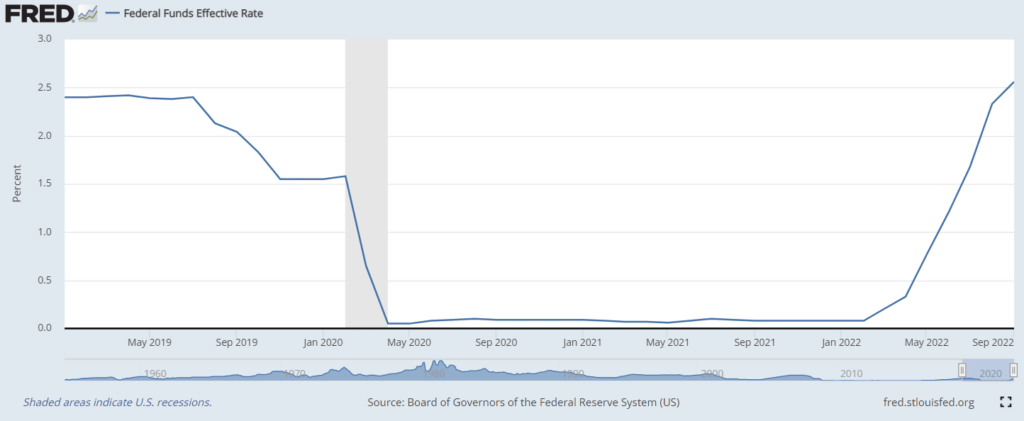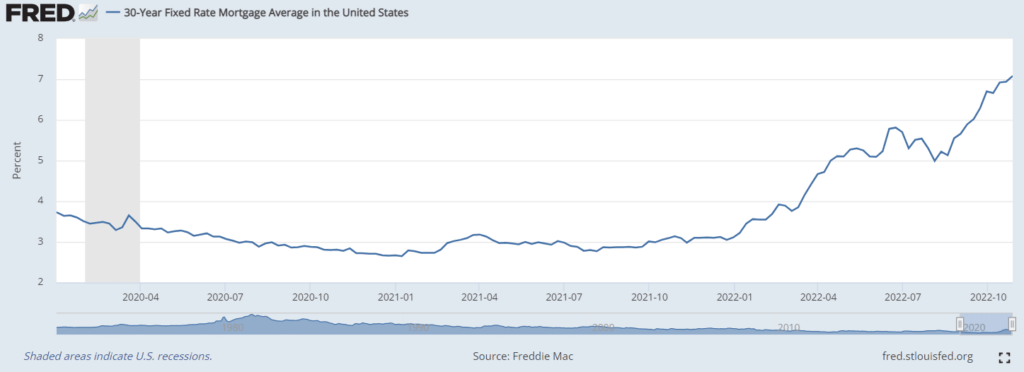Quick Look
- The Fed will likely raise interest rates by 75 basis points this week.
- Economists expect another 50-basis-point hike in December.
- Interest rates on credit cards and mortgages will continue to increase as a result.
- Savings account yields could increase as well.
- The Fed hopes to stop hiking rates early next year, but that depends on inflation and the economy.
The Federal Open Market Committee of the Federal Reserve is almost certain to hike the closely watched federal funds rate by 75 basis points at its meeting this week. Federal Reserve Chair Jerome Powell will announce the move at 2pm Eastern Time on Wednesday, Nov. 2.
The FOMC’s November rate increase is the latest in a series of hikes beginning early this year. It will boost the target federal funds rate to 3.75% to 4%, a 375-basis-point jump, and immediately increase borrowing costs.
Find out what to expect from the Fed’s next meeting, what it means for the broader economy, and how you can prepare your finances for what’s to come.
The FOMC’s November 2022 Meeting: What to Expect
The vast majority of economists polled by Reuters this month expected the FOMC to raise the federal funds rate by 75 basis points. It’ll be the fourth 75-point increase since June.

Motley Fool Stock Advisor recommendations have an average return of 397%. For $79 (or just $1.52 per week), join more than 1 million members and don’t miss their upcoming stock picks. 30 day money-back guarantee. Sign Up Now
There’s not much suspense around the rate hike announcement itself. The market would be shocked by anything less than a 75-point increase.
But at Powell’s post-announcement press conference, he’ll answer questions from financial journalists desperate for insight into the FOMC’s thinking. And if past is prologue, his answers could precipitate a new round of market volatility. (Or not.)
We won’t be in attendance, but we’d ask him these four questions if we could.
Why Is the FOMC Raising Interest Rates Again?
In a word, inflation.
Annualized inflation remains above 8%, far higher than the Federal Reserve’s 2% target. The FOMC appears to be rerunning the Fed’s playbook from the early 1980s, when then-Chair Paul Volcker pushed the fed funds rate to 19% in a bid to quash sky-high inflation.
How Do Fed Funds Rate Hikes Affect the Economy?
The federal funds rate is a key benchmark interest rate for banks and other lenders. Raising it increases the cost of the short-term loans most financial institutions need to operate normally. They pass those costs to their borrowers via higher interest rates on credit cards, real estate loans, and business loans and credit lines.
The correlation isn’t always perfect, but economic activity tends to slow as borrowing costs increase. Consumers buy less on credit and put off major purchases. Businesses delay or cancel planned investments. They may lay off contractors and employees if they can’t control costs elsewhere.
With businesses making less money and fewer people drawing paychecks, a feedback loop develops. Demand for goods and services falls. The economy slows further, maybe tipping into recession. Declining demand helps cool inflation, but at the (hopefully temporary) cost of livelihoods and profits.
When Will the Fed Stop Raising Rates?
Economists expect the federal funds rate to top out in the first or second quarter of 2023. They expect a terminal rate — the highest the Fed will let the funds rate get before it takes action — of between 4.75% and 5.25%, according to the FedWatch predictive tool. But some banks expect a terminal rate closer to 6%, which would cause even more economic pain.
Once it hits the terminal rate, the Fed will probably keep rates steady for a while, unless the economy is in really rough shape. Then it’ll pivot — market-speak for beginning a rate-reduction cycle. Markets love it when the Fed pivots because it means lower borrowing costs and, usually, higher business profits.
Will the Fed Cause a Recession?
According to Reuters’ October 2022 economist survey, it’s likelier than not. About 65% of respondents predicted a U.S. recession by the fourth quarter of 2023.
Chair Powell seems unbothered by the possibility of a recession. Though he hasn’t said outright that he’s rooting for a recession, he’s on the record saying that asset prices (especially real estate values) need to come down. And in August, he told attendees at the closely watched Jackson Hole Economic Symposium that the Fed’s commitment to fighting inflation was “unconditional.”
The stock market tanked as he spoke.
What the November Rate Hike Means for Your Finances
What does the Federal Reserve’s latest interest rate hike mean for your wallet? Four things:
- Your Credit Card Interest Rate Will Go Up. Like clockwork, credit card companies raise interest rates in lockstep with the Fed. Expect your credit card rates to increase by 75 basis points within a week of the rate hike.
- Your Savings Account Yield Could Increase. The relationship between savings yields and the federal funds rate isn’t quite as strong, but it’s still there. Banks just tend to raise yields more slowly than the Federal Reserve because they make money off the spread between what they pay customers and what they themselves pay to borrow.
- Your Fixed Mortgage Rate Won’t Increase. Your fixed mortgage rate is, well, fixed. At this point, refinancing probably isn’t in your best interest, so just sit back and enjoy the rate you locked in when money was cheaper. If you have an adjustable-rate mortgage, your rates will go up, and it might be time to consider refinancing before it gets worse.
- Your Retirement Portfolio Will Remain Volatile. It has been a rough year for stocks and bonds. We’re not in the business of stock-picking, but it’s a fair bet that market volatility will persist due to ongoing economic uncertainty and uncertainty around just how far the Fed will go to fight inflation.
Your Personal Finance Playbook: What to Do As Interest Rates Rise
The negatives of higher interest rates outweigh the positives, but it’s not all bad. Do these things now to protect yourself and make your money work harder.
- Move to a High-Yield Savings Account. After the Nov. 2 hike, the most generous savings accounts will yield 3% or better. That’s much lower than the inflation rate, but it’s better than traditional big banks’ paltry savings yields, which haven’t budged during this hiking cycle. Move your money if you haven’t already.
- Pay Off Your Credit Card Balances. You should never carry a credit card balance if you can avoid it, but it’s especially painful when interest rates are high. Make a plan to pay off your existing balances as soon as you can. If you need help, work with a nonprofit credit counseling agency.
- Buy Series I Bonds Before May 2023. They’re your best bet to fight inflation, better than any savings account. Rates reset twice per year, on Nov. 1 and May 1. With inflation probably at its peak, the May 1 rate is likely to be lower than the current 6.89% rate, which is already down from 9.62% earlier this year.
- Buy a New Car Sooner Than Later. Auto loans are a weird bright spot for consumers so far this hiking cycle. Dealer financing rates haven’t increased much since 2021 as car dealers fight softening demand for new cars while undercutting banks and credit unions that also offer auto loans.
How We Got Here: Fed Funds Rate Hikes in 2022
The FOMC has raised rates at a breakneck pace in 2022.
The current target rate of 3% to 3.25% is 300 basis points higher than it was at the beginning of the year. The gap is likely to increase to 375 basis points after the November meeting.
Economists polled by Reuters expect another rate hike from the next FOMC meeting on Dec. 13 and 14. The consensus is for a 50-basis point increase in December rather than 75.
If it pans out, that marks the beginning of the long-awaited Fed pivot. But hotter-than-expected inflation readings or job growth numbers between now and then could keep the Fed in its 75-points-per-meeting groove through the end of 2022.
| Meeting Date | Fed Funds Rate Change (bps) |
| March 17, 2022 | +25 |
| May 5, 2022 | +50 |
| June 16, 2022 | +75 |
| July 27, 2022 | +75 |
| Sept. 21, 2022 | +75 |
| Nov. 2, 2022 | +75* |
| Dec. 14, 2022 | +50* |
The rapid increase comes after two years of rock-bottom interest rates. The Fed slashed rates by 150 basis points between February and April 2020 as the COVID-19 pandemic pummeled the economy. They stayed near zero through 2021.
One More Fed Move to Watch: Quantitative Tightening
The FOMC’s interest rate decisions might grab headlines, but they’re not the only moves the Fed makes to steer the economy.
Since the Great Financial Crisis of the late 2000s, the Fed has been in the business of buying, holding, and (occasionally) selling U.S. government bonds and other government securities. When the Fed buys securities, it’s called quantitative easing (QE). When it sells them or allows them to mature without replacing them, it’s called quantitative tightening (QT).
Quantitative easing increases the U.S. dollar supply, which is why some say the Fed “prints money” in response to economic weakness. Quantitative tightening decreases the dollar supply, though you don’t hear much about the Fed “burning money” to fight inflation.
Quantitative Tightening in 2022
The Fed bought more than $4 trillion in government securities between early 2020 and early 2022, adding to a sizable stockpile left over from the Great Financial Crisis. It began QT in June 2022 and accelerated the pace in September.
Since then, the Fed has reduced its balance sheet by about $95 billion each month. But with nearly $9 trillion still on its books, it’ll take more than 7 years to fully unwind its purchases. That’s far longer than economists expect the current cycle of interest rate hikes to last — and assumes no economic crises that demand quantitative easing between now and then.
Why Quantitative Tightening Matters for You
QT isn’t some abstract high-finance maneuver. By increasing the supply of U.S. government bonds, it puts upward pressure on rates, compounding the effects of fed funds rate hikes. For example, the yield on the closely watched 10-year U.S. Treasury bill jumped from about 1% in January 2021 to about 4% in late October 2022.
The combined effect of QT and fed funds rate hikes shows up in interest rates tied to both benchmarks, like mortgage rates. That’s why the average 30-year fixed rate mortgage rate increased by about 450 basis points between January 2021 and October 2022 — compared with just 300 basis points for the federal funds rate.
So if you’re in the market for a new house or want to open a home equity line of credit soon, the fed funds rate won’t tell the whole story. If the Fed accelerates QT, bond yields — and thus mortgage rates — could continue to rise even after rate hikes cease and inflation floats down to historical norms.


